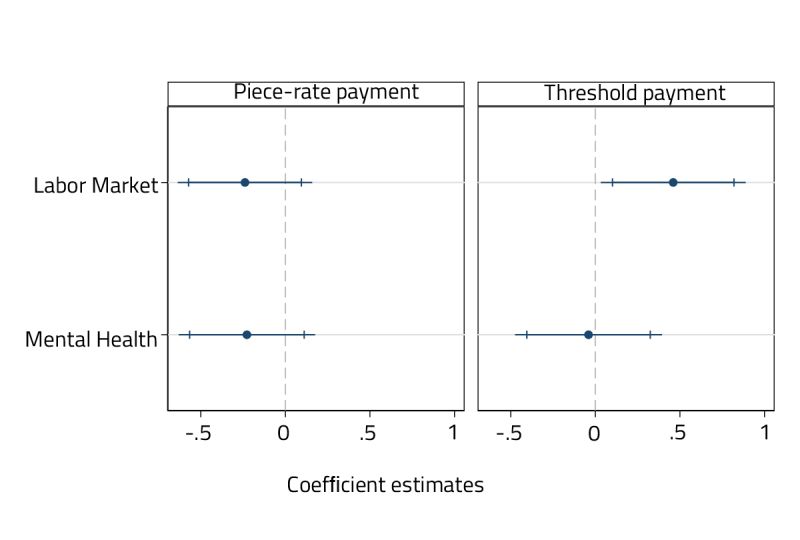Timothée Demont, Daniela Horta Sáenz, Eva Raiber, 2024, Scientific Reports ,14(1)
»
Under the threshold payment scheme, the labor market treatment positively
and significantly influenced students’ cognitive performance.
RESEARCH QUESTION
In today’s world, distressing problems and future uncertainties are increasingly pervasive and salient. Young people, in particular, are constantly confronted with worrisome issues through digital media and social networks. Current examples include the Covid-19 pandemic, economic slowdown, and climate change.
Do these worries affect cognitive performance? Concerns about such issues can be distracting, making it hard to concentrate on the task at hand and imposing a cognitive burden that depletes limited cognitive resources. However, psychological literature suggests a possible opposite effect known as ‘tunneling.’ Given the high cost of bad decisions when resources are limited, a scarcity mindset can focus attention on the problem at hand.
Despite the significant implications of these contrasting effects, there is limited causal evidence regarding their existence, relative strength, and underlying mechanisms, especially in real-life contexts involving genuine worries and stakes. This paper aims to fill this gap by generating meaningful exogenous variations in both the type of worry and the emphasis on a performance goal.
In an online experiment conducted during the Covid-19 pandemic (N=1503), we investigate the impact of different types of worries on the cognitive performance of university students. We leverage reallife sources of anxiety made salient by the pandemic: (i) mental health issues related to social restrictions and (ii) future labor market uncertainties linked to the economic contraction. Our treatments are motivated by evidence that young people during the pandemic mainly worried about uncertainty in employment opportunities and the psychological burden of social restrictions. Additionally, we cross-randomize the method of rewarding performance, recognizing that cognitive performance can be influenced by what is at stake. Participants are either compensated for each correct answer (piece-rate payment) or receive payment upon reaching a specified threshold (threshold payment), defined as correctly solving half of the tasks. This reflects many real-life scenarios, such as passing an academic, qualifying, or entrance exam or reaching a performance threshold to qualify for a bonus, job, or promotion.
PAPER’S FINDINGS
We measured cognitive performance through a Raven-matrices-like task, where participants had to find the missing item in an incomplete series of colorful and abstract forms. The figure illustrates the treatment effects on cognitive performance, quantified by the number of correct matrices (out of 10) for each payment scheme.
Under the piece-rate payment scheme, no significant effects were observed. However, under the threshold payment scheme, the labor market treatment positively and significantly influenced students’ cognitive performance. Treated students improved their performance by 7% relative to the control group mean. In contrast, the mental health treatment did not result in any significant effect. This finding aligns with the concept of a ‘tunneling effect’ of scarcity, or with a positive stress effect.
We further analyzed treatment effect heterogeneity across pre-specified important socio-economic characteristics, and also used a causal machine learning method («causal forest») on a large number of covariates. Both analyses indicated that the positive effect was primarily concentrated among students with greater financial and social resources, suggesting an inequality-widening mechanism. This adds to the evidence that the negative consequences of lockdowns on student learning were particularly severe among students from less-educated and poorer families.
Conversely, we found limited support for a negative stress effect or a ‘cognitive load effect’ of scarcity, as the mental health treatment had a negative but insignificant average effect on cognitive performance. However, there was a negative response among psychologically vulnerable individuals when the payout was not conditioned on reaching a goal.

Figure: Treatment effect on cognitive performance
Note: Treatment effects on cognitive performance according to payment scheme, with 90% and 95% confidence intervals. The dependent variable is the number of correct matrices (minimum possible: 0, maximum possible: 10). Pre-registered baseline controls include gender, field of study, undergraduate, scholarship recipient, as well as age and number of correct matrices in the first round.
→ This article was issued in AMSE Newletter, Summer 2024.






